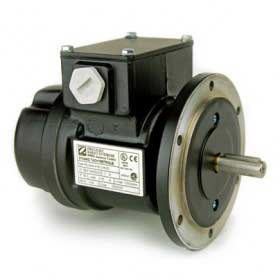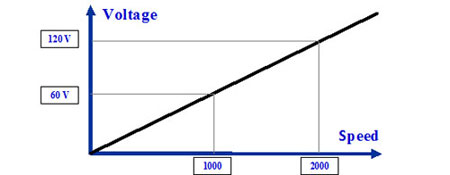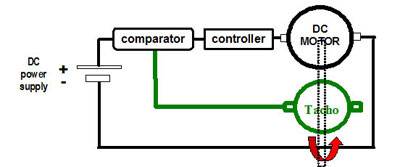What is a DC Brushed Tachogenerator?
A tachogenerator gauges the speed of rotation of a shaft or disk (from Greek: tachos = speed, metron = measure) as in a motor or other machine. The device usually displays the rate of revolutions per minute (rpm) on a calibrated analogue dial.

Radio Energie REO444 Type 60V/1000rpm Flange mounted brushed Tachogenerator with a terminal box
The DC motor speed is continually adjusted by the controller according to the speed measured by the tachogenerator. The tachogenerator transforms the motor speed into voltage so that the comparator may check and adjust if there’s a difference between the setting speed and the effective speed.
Generalities
Over recent years, the control process of electric rotating machines has undergone a number of changes linked to the development of new technologies and new material. In the majority of cases, these machines need a speed measuring device a tachogenerator or encoder which gives an accurate measurement of the speed (RPM) in the closed loop process.
The use of digital drives or PLC's in automated systems suggests the use a digital speed sensor (encoder) to control the speed of the motor. However, the electronics usually permits the drives with inputs of 0-10V to use an analog speed sensor (tachogenerator). Therefore, the use of tachogenerators is possible for a lot of applications. The advantages are in excellent performances and a low time constant.
Principles and Applications
A tachogenerator is an electric generator that provides a voltage proportional to the speed. As tachogenerators are key components in automated systems. They must be strong, reliable, accurate, sensitive and stable. These analogical sensors (DC tachogenerators, AC tachogenerators, brushless DC tachogenerators) are adapted to every industry like machine tools, proportioning systems, handling and lifting systems, lifts, paper manufacturing machinery, textile machines, glass production lines, rolling mills, railway industry, etc.
These sensors are manufactured in different mechanical variations and frame sizes, and also in various electrical characteristics i.e. voltages between 2 volts and 6000 volts at 1000 rpm, rotating speed up to 12000 rpm, machines with shaft and bearings, machines with hollow shaft. Tachogenerators are available from different manufactures but in 1949 Radio-Energie started to make tachogenerators and the REO444 type followed shortly and established itself as the industry standard and has been copied many times.


